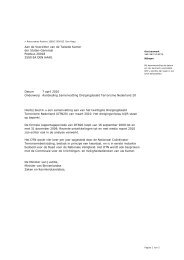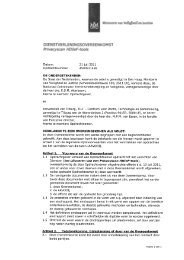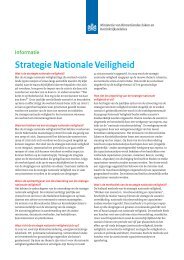Countering Violent Extremist Narratives
Countering Violent Extremist Narratives
Countering Violent Extremist Narratives
- No tags were found...
Create successful ePaper yourself
Turn your PDF publications into a flip-book with our unique Google optimized e-Paper software.
10 Heterogeneous Counter-<strong>Narratives</strong>and the Role of Social DiplomacySadik HarchaouiChair of the Board of Directors of the Institute for Multicultural Development FORUMIntroductionThe fight against terrorism is conducted in various ways: via war and the deployment of military resources,by means of a state’s intelligence apparatus and through the application of judicial instruments. Fightingthe underlying ideology that terrorists use to legitimise their violence has also been given a central placein counterterrorism policies. Combating extremist views is viewed as the ‘soft’ side of such a policy, andit plays a pivotal role in the battle to win the hearts and minds of the violent extremists and those in theirnearby environment that – both actively and passively – support their actions. In this so-called battle ofideas, governments attempt to undermine the particular narrative of jihadi extremists. Their usually simplisticmessage is: the ‘West’ is the enemy of Islam, the only way to counter the West is via violence and thereforejihad is the only option. Western governments have developed various strategies (de-radicalisation programs,rehabilitation programs, empowerment of liberal Muslims, etc.), but recently much emphasis has beenput on the development of ‘counter-narratives’. This is not an easy task, especially when the messengeris a state. Besides, in the current media age, one must take into account the symbiotic relationship thatexists between extremists and the media. The effectiveness of a counter-narrative strategy therefore largelydepends on the manner in which the (new) media report, distribute and interpret the narrative.There are, however, more (strategic) questions that need to be dealt with. What, for instance, is the correctscale of the counter-narrative? Is this a global narrative concentrated on stories about the West and Islam?Or should it be a national or a local narrative? Additionally, the recipient of the counter-narrative needsto be defined. Is it the Muslim population as a whole, or certain Muslim groups with particular religiousbeliefs? Or solely radicals and extremists, and if so, who among them precisely? Or should the counternarrativesbe aimed at more general questions of identity and uncertainties of individuals? Finally, there isthe problem of content. Is the counter-narrative aimed at dealing with the extremists’ violent ideology, thereligious misinterpretations, the psychological implications, the actual violent practices, or the conceptof martyrdom? All in all, developing effective strategies to counter the violent extremist narrative is not asimple task.In any case, each narrative begins with an understanding of developments in the Islamic world, the Islamicreligious movements and their manifestations in the country in which the target audience resides. A goodrelationship with the Islamic world in the broad sense of the word is vital. In this chapter, the author willrefrain from dealing into depth with the factors relevant for the effectiveness of counter-narrative strategies,since most of these have already been discussed in other chapters in this volume. Instead, emphasise willbe put on a tool that will constitute a necessary complement to public diplomacy and strategic messagingin this context, a vehicle to tell stories: social diplomacy.Social diplomacy may be a useful instrument to this end: it emphasises the societal dimension of publicdiplomacy and the involvement of independent actors beyond the government. As a result of this involvementof different actors, the narrative that counters jihadist extremism will be a heterogeneous one. In this way,both the form and the content of the counterstrategy represent the discourse of democracy. However,before elaborating upon the role of civic organisations, we should investigate and clarify the tensions thatmay exist between NGOs and the government when dealing with this issue.Social diplomacy 1The concepts of public and social diplomacy are closely linked to the notion of soft power, defined by124125
















